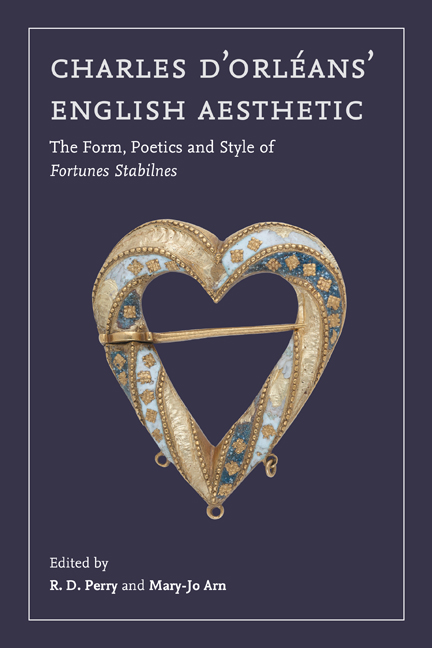Book contents
- Frontmatter
- Dedication
- Contents
- List of Illustrations
- List of Contributors
- Acknowledgements
- Abbreviations
- Introduction
- 1 The Two Dreams of Charles d’Orléans and the Structure of His English Book
- 2 Charles d’Orléans’ Cross-Channel Poetics: The Choice of Ballade Form in Fortunes Stabilnes
- 3 The English Roundel, Charles’s Jubilee, and Mimetic Form
- 4 A Grieving Lover: The Work of Mourning in Charles’s First Ballade Sequence
- 5 Charles d’Orléans’ English Metrical Phonology
- 6 The English Poetry of a Frenchman: Stress and Idiomaticity in Charles d’Orléans
- 7 Verb Use in Charles d’Orléans’ English
- 8 Charles d’Orléans and His Finding of English
- 9 Aureation as Agon: Charles d'Orléans versus John Lydgate
- 10 Charles d’Orléans, Harley 682, and the London Book-Trade
- 11 The Form of the Whole
- Select Publications, 2007–2020
- Index
5 - Charles d’Orléans’ English Metrical Phonology
Published online by Cambridge University Press: 14 October 2020
- Frontmatter
- Dedication
- Contents
- List of Illustrations
- List of Contributors
- Acknowledgements
- Abbreviations
- Introduction
- 1 The Two Dreams of Charles d’Orléans and the Structure of His English Book
- 2 Charles d’Orléans’ Cross-Channel Poetics: The Choice of Ballade Form in Fortunes Stabilnes
- 3 The English Roundel, Charles’s Jubilee, and Mimetic Form
- 4 A Grieving Lover: The Work of Mourning in Charles’s First Ballade Sequence
- 5 Charles d’Orléans’ English Metrical Phonology
- 6 The English Poetry of a Frenchman: Stress and Idiomaticity in Charles d’Orléans
- 7 Verb Use in Charles d’Orléans’ English
- 8 Charles d’Orléans and His Finding of English
- 9 Aureation as Agon: Charles d'Orléans versus John Lydgate
- 10 Charles d’Orléans, Harley 682, and the London Book-Trade
- 11 The Form of the Whole
- Select Publications, 2007–2020
- Index
Summary
When writing syllabic poetry in his native French, Charles d’Orléans contributed to two poetic traditions, the line of eight syllables (octosyllabe) and the line of ten (vers de dix). When he came to translate his French poetry into English and to compose new English poetry, Charles employed the corresponding accentual-syllabic metres, tetrameter and pentameter. These metrical choices in a second language necessarily held a different cultural-historical significance, since the French and English literary fields did not develop in lockstep. Whereas the other three metres were centuries old by the time of the battle of Agincourt, Geoffrey Chaucer’s pentameter dated only to the 1380s. The Parliament of Fowls and Troilus and Criseyde were the first substantial works in this new English verse form. French also had no equivalent of alliterative verse, the first metre in English. William Langland's bestseller Piers Plowman lent alliterative verse prominence in late fourteenth- and early fifteenth-century London literary culture. The presence of alliterative verse on the English literary scene made tetrameter and pentameter more marked formal departures than either of the major French metres.
Among the challenges facing Charles in English versification was metrical phonology. That is, he had to decide how to map the English language onto English metre. Notice that I have said ‘decide’. Linguists assume that metrical language mirrors spoken language, but I understand metrical phonology as a culturally contingent component of metrical style. Like other components of style, it varies according to its own historical logic. I propose to demonstrate that Charles's English metrical phonology was aberrant. In French metre, Charles employed the full range of obsolescent final -e's that tradition had handed down. By contrast, he versified without much of the historical baggage of English metre, likewise packed into certain final -e's in the fifteenth century.
It will be convenient to begin with a capsule description of the London English metrical status quo before Charles arrived on the scene. Langland and Chaucer shared a linguistically conservative metrical phonology, one that included historical forms of words from Old English, Old French, Old Norse, and Latin alongside contemporary spoken forms.
- Type
- Chapter
- Information
- Charles d’Orléans' English AestheticThe Form, Poetics, and Style of Fortunes Stabilnes, pp. 122 - 144Publisher: Boydell & BrewerPrint publication year: 2020



